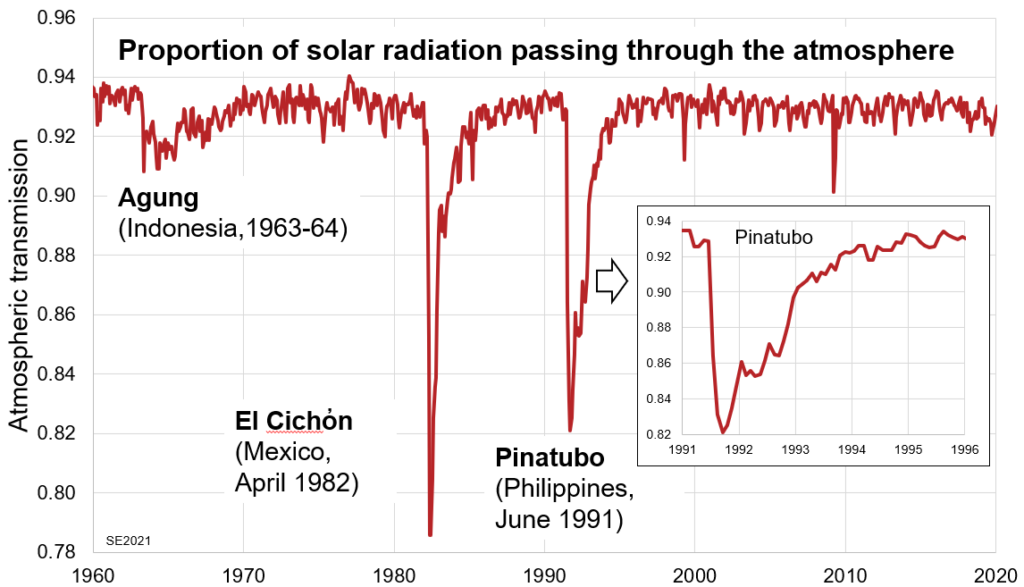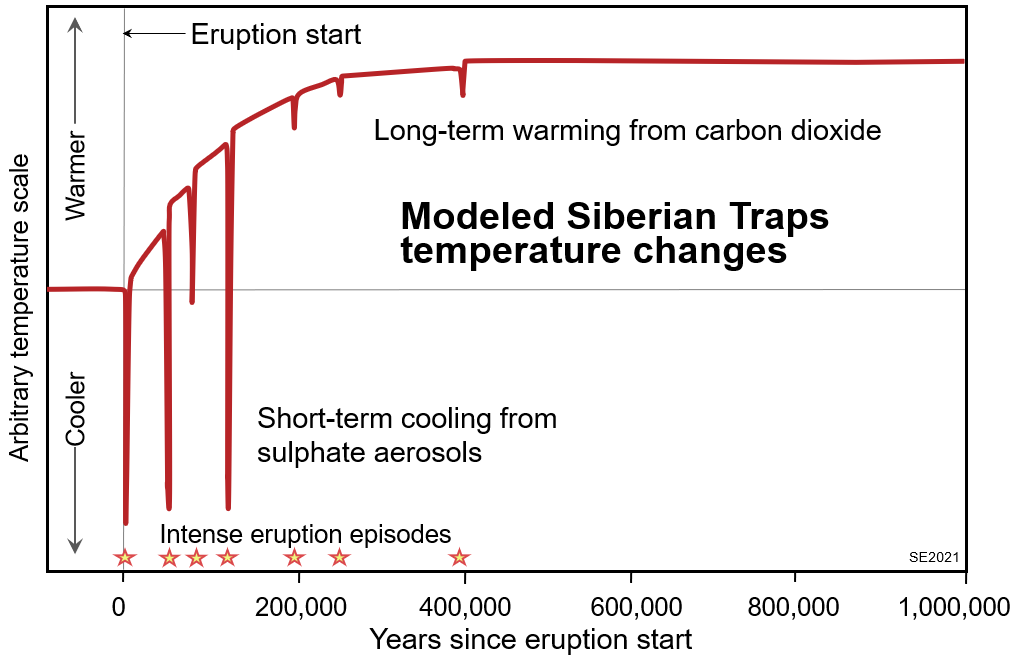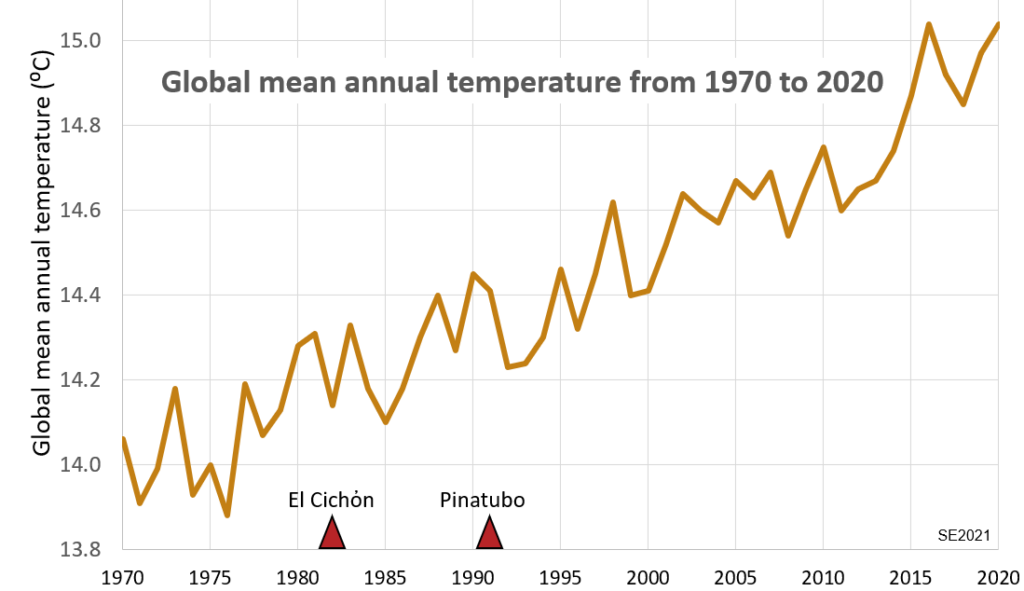3.3 Volcanism and Climate Change
Significant volumes of gases are emitted during volcanic eruptions, and some of these can have climate effects if the eruption is large. The most recent large volcanic event was the Pinatubo (Philippines) eruption in 1991. The amounts of three important gases emitted during that event are compared with the amounts of these same gases normally present in our atmosphere in Table 3.3.1. It’s easy to see that the amount of water emitted by an eruption such as Pinatubo is insignificant compared with the amount already in the atmosphere. It’s also important to recognize that water has a relatively short lifetime in the atmosphere (about 9 days), so most of the 400 million tonnes added by Pinatubo was likely rained out within a week and so would have had no climate impact.
| Atmospheric Gases | Current atmospheric reservoir (millions of tonnes) | Amount emitted during the 1991 Pinatubo eruption (millions of tonnes) |
| H2O | 16,000,000 | 400 |
| CO2 | 3,200,000 | 40 |
| SO2+SO4 | 2 | 20 |
Volcanic carbon dioxide emissions are also tiny compared with the current atmospheric reservoir, but CO2 has a much longer residence time (hundreds to thousands of years),[2] so there is the potential for volcanic CO2 to lead to greenhouse-gas warming if a higher-than-average level of volcanism is sustained for centuries or more. The Pinatubo eruption lasted for less than a day, so there was no warming effect.
On the other hand, sulphur emissions from volcanic eruptions are typically large compared with the atmospheric reservoir of sulphur, and that’s why a major volcanic eruption can have a rapid and significant climate effect. In this case the effect is cooling, not warming, because sulphur gases get quickly converted to sulphate aerosols, tiny droplets or crystals that block incoming sunlight. Sulphate aerosols do not stay in the atmosphere for more than a few years in most cases, so the climate effect tends to be quite short.
The atmospheric effects of some recent volcanic eruptions are shown on Figure 3.3.1. At near-equatorial latitudes the Pinatubo eruption blocked almost 20% of incoming sunlight for several months and 10% of sunlight for almost 18 months. (Have a look at Exercise 3.2, below, and decide for yourself if and how the Pinatubo eruption affected the Earth’s climate.)


There have been numerous large volcanic eruptions in recent millennia, but none has affected the Earth’s climate by more than a few degrees C, nor for more than several years. Really significant climate change can be caused by really large eruptions and there have been some of those in the distant past. One example is the Deccan Traps in India at around 66 Ma. This event—which probably originated from a large mantle plume—involved the eruption of about 200,000 times as much magma as at Pinatubo—and correspondingly greater amounts of gases—over a period of about 30,000 years.
Although there would have been some cooling related to sulphur emissions, the main climate effect was significant warming from CO2 emissions (up to 2⁰ C for as much as 500,000 years). However, the environmental effects are not fully understood because this coincided (and might have been partly caused by) the dinosaur-ending extra-terrestrial collision at the end of the Cretaceous.
The Siberian Traps eruption of 252 Ma was about four times larger than Deccan. It is estimated that about two-thirds of the magma erupted over approximately 300,000 years at the boundary between the Permian and Triassic Periods.[3]There is evidence for strong warming, in the order of 10⁰ C, for at least the first ten million years of the Triassic. Figure 3.3.2 provides a conceptual model of how climate change might have progressed from the start of the Siberian Traps eruption (time 0) and then for the first million years of the Triassic. Assuming that the volcanic eruption proceeded episodically (which is typical), there would have been short periods of cooling caused by sulphate aerosol pulses, and increasingly intense warming caused by the progressive buildup of atmospheric carbon dioxide.
The Siberian Traps eruption coincided with the most catastrophic extinction of all time. Over 95% of all marine species and 70% of terrestrial species disappeared from the fossil record at the end of the Permian. Life on Earth was forever changed, or put differently, the future course of evolution—including the origin and evolution of mammals—was significantly affected by that event.
Exercise 3.2 Volcanism and the Climate
Figure 3.3.3 shows the global mean annual temperature for the period from 1970 to 2020, along with the timing of the large 1982 El Chichὀn and 1991 Pinatubo eruptions. Look closely at the temperature variations and decide whether, and how, those eruptions affected the global climate, and for how long.
Figure 3.3.3 Global Temperature Record for the Period, 1970 to 2020
Exercise answers are provided Appendix 2
Media Attributions
- Figure 3.3.1 Steven Earle, CC BY 4.0, based on public domain data available at NOAA Earth System Research laboratory, Global Monitoring Division, https://www.esrl.noaa.gov/gmd/grad/mloapt.html
- Figure 3.3.2 Steven Earle, CC BY 4.0, based on a figure in Black, B. A., Neely, R. R., Lamarque, J. F. et al. (2018). Systemic swings in end-Permian climate from Siberian Traps carbon and sulfur outgassing. Nature Geoscience 11, 949–954. https://doi.org/10.1038/s41561-018-0261-y
- Figure 3.3.3 Steven Earle, CC BY 4.0, based on public domain data from NASA Goddard Institute for Space Studies, https://data.giss.nasa.gov/gistemp/tabledata_v4/GLB.Ts+dSST.txt
- H2O and CO2 reservoir numbers are derived from atmospheric concentrations. The sulphur reservoir value is from: Manktelow, P. T., Mann, G. W., Carslaw, K. S., Spracklen, D. V., and Chipperfield, M. P. (2007). Regional and global trends in sulfate aerosol since the 1980s, Geophysical Research Letters, 34, L14803. https://doi.org/10.1029/2006GL028668. The data for the 1991 Pinatubo eruption are from: Self, S., Jing-Xia, Z., Holasek, R., Torres, R., and King, A., (1997). The atmospheric impact of the 1991 Pinatubo eruption. In Newhall, C.G. and R.S. Punongbayan (Eds.). Fire and mud: Eruptions and Lahars of Mount Pinatubo, Philippines. University of Washington Press. https://pubs.usgs.gov/pinatubo/self/ ↵
- CO2 is removed from the atmosphere through uptake by plants, but when plants die and decay that carbon returns to the atmosphere. It is also removed through dissolution into the ocean, but the surface of the ocean can only take up so much CO2 before becoming saturated, and so the very slow rate (centuries to millennia) of ocean turnover becomes the limiting factor. See section 2.10 in the IPCC 4th Assessment Report (2018): Forster, P., Ramaswamy, V., Artaxo, P. , Berntsen, T. Betts, R., Fahey, D.W. Haywood, J., Lean, J., Lowe, D.C., Myhre, G., Nganga, J., Prinn, R., Raga, G., Schulz M., & Van Dorland, R. (2007). Changes in atmospheric constituents and in radiative forcing. In Solomon, S., Qin, D., Manning, M., Chen, Z., Marquis, M., Averyt, K.B., Tignor, M. & Miller, H.L. (Eds.), Climate Change 2007: The Physical Science Basis. Contribution of Working Group I to the Fourth Assessment Report of the Intergovernmental Panel on Climate Change. Cambridge University Press. https://www.ipcc.ch/site/assets/uploads/2018/02/ar4-wg1-chapter2-1.pdf ↵
- Burgess, S. D., & Bowring, S. A. (2015). High-precision geochronology confirms voluminous magmatism before, during, and after Earth’s most severe extinction. Science advances, 1(7), e1500470. DOI: 10.1126/sciadv.1500470 ↵

